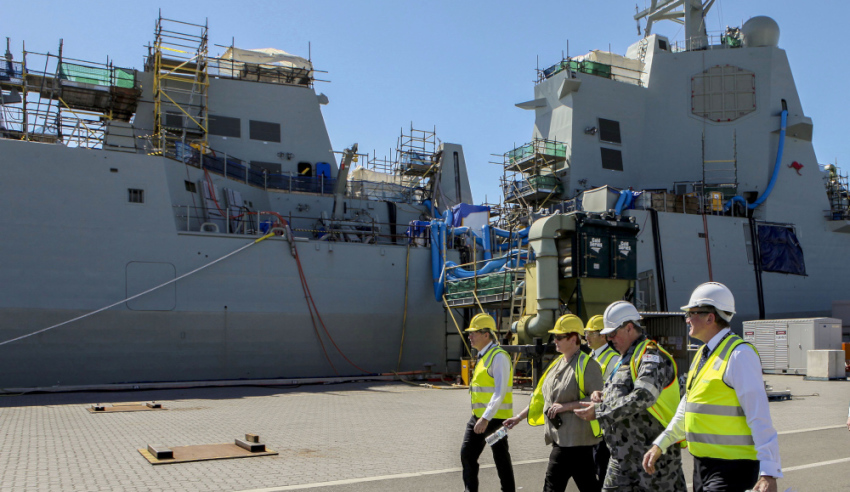COVID-19 came as a dramatic shock for the Australian and global economies. The lessons learned about workforce agility and retention, collaborative innovation and industry working with government to overcome the challenges should not be forgotten as business pivots to respond to the new normal, explains Rob Kremer of Kinexus.
To continue reading the rest of this article, please log in.
Create free account to get unlimited news articles and more!
We have all learnt so much about ourselves, our communities and our workplaces since the COVID-19 pandemic really hit in March 2020. Almost every aspect of society has been forced to adapt in many ways, and the defence industry is no exception. The helicopter view of the industry that my job affords has given me the opportunity to share some observed trends.
I will describe the evolution of the workforce activity I have seen in ‘phases’, confident that it will not be confused with the ‘stages’ term, which has now been appropriated for identifying the various severities of lockdowns enforced by governments.
Phase 1 - March to May 2020
As at the start of the global financial crisis (GFC) in 2008, the worldwide realisation that COVID-19 was a ‘thing’ led to an almost universal cessation of hiring activities as companies paused workforce growth to dedicate their resources on business continuity and the safety of workers.
Phase 2 - May to June 2020
In this period most companies had addressed the above-mentioned priorities and were able to take stock of their workforce needs in the new reality. Concurrently, they also developed and implemented strategies that allowed them to start the hiring, inducting and setting to work of new employees. For services workers this often looked like a day or two of on-site induction and IT set up and then working remotely.
Where staff had to be present on-site, new rostering and physical distancing practices were used. Interestingly, we did not see much evidence of layoffs, and even contracted workers seemed to be immune from the fate that adjacent industry contractors experienced.
A large reason for this was the strong and early words and actions from the Commonwealth supporting defence industry employment.
Phase 3 - July onwards
As defence industry became accustomed to the ‘new normal’, different sectors responded to the changes with differing speed and success. The ICT sector reacted fastest, arguably because they were already relatively well set up for remote working, and the professional services employers were also able to react quite quickly where their clients allowed.
Manufacturing and logistics businesses have the greatest level of complexity in responding to government health requirements but most are now operating to the full extent they can under the current environment.
Many businesses are taking a cautious approach to hiring, but the reality is that demanding project schedules mean that workforce development must continue, and any delayed hiring is adding to the already pent-up demand.
So, what were job-seekers doing in this time? In Phase 1 they were staying put, and in Phase 2 they were being very careful when weighing the idea of changing employers. In May Kinexus surveyed the defence industry worker community on their thoughts and expectations during the time of COVID-19.
Perhaps unsurprisingly, 54 per cent thought that COVID-19 made it a great deal more risky to change employers, with a further 22 per cent feeling it was somewhat more risky. This quite reasonable sentiment simply added to the challenge faced by employers who need to grow their workforces.
So, what does the future hold?
Defence industry did not really feel the pain from the GFC until $20 billion was taken out of the defence budget in 2010, which led to a six-year decline in the defence industry workforce.
So, it was with a great deal of relief to many when in July the government not only reiterated its commitment to defence spending, but committed to spend $270 billion over the next decade. Of course, this should do much to boost the confidence of the industry, and give it the confidence to invest in the future workforce.
Having the funding is good, but we must be prepared to tackle some new and existing risks and opportunities.
I think that we are yet to feel some of the downside of wide-spread remote working. Companies will have to be on their game if they are to replicate the opportunities for productive informal communication and collaboration that come from ongoing interaction between co-workers in a physical workplace.
Secondly, we should take this opportunity to deliberately seek out, attract and integrate people from industries that have an underemployed workforce. Given the voracious demand for workers, and no latent supply of defence experienced workers, this is something industry has to do anyway, so let’s not waste a good crisis!
Employers, already faced with a daunting workforce generation challenge, will have to work hard ongoing to address concerns of current and target employees around job security and health and wellbeing. Kinexus asked the worker community what would make them confident to consider taking up a role with a new employer.
The top three factors were assurance of ongoing work, support for non-conventional working arrangements and flexibility around hours of work.
Lastly, and encouragingly, many employers now see the possibility of taking the work to the workers, rather than requiring the workers come to the work. This will allow government and industry to establish workforces in geographic locations where supply meets demand, and there is little energy wasted on inefficient competition over scarce resources.
We are lucky to live in a country that to date has fared relatively well in a public health sense. We must take the lessons that we are learning about how to work efficiently in a COVID-19 world, and marry this with the opportunity presented by investment and a growing potential labour pool to create a highly skilled and valuable defence industry workforce.

 Login
Login







